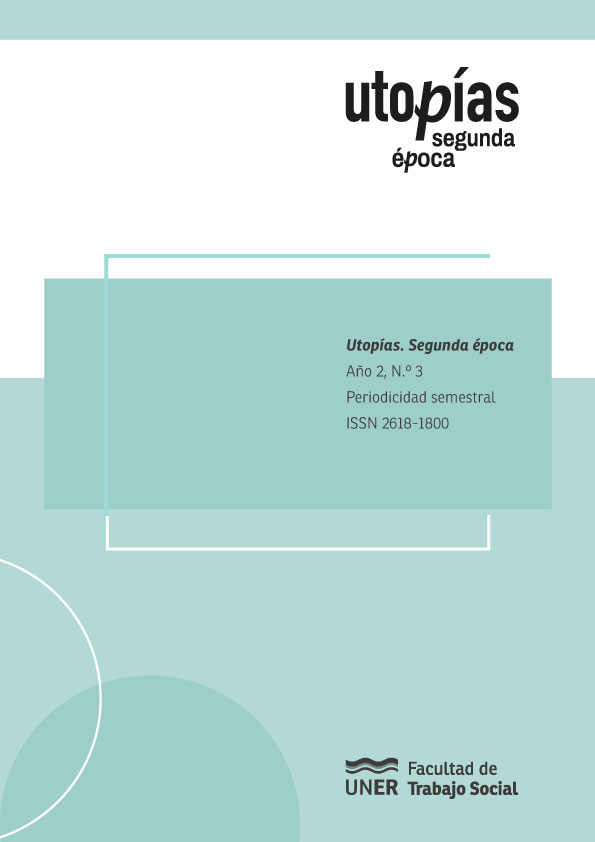Es más caro vivir adentro que afuera: usos del dinero y costos de la vida en la cárcel
##plugins.themes.bootstrap3.article.main##
Resumo
Una serie de hechos etnográficos nos permitirán analizar qué se necesita para vivir en un contexto de privación de libertad ambulatoria. Partiremos de los intercambios económicos dentro de una cárcel de varones de Entre Ríos, los cuales son fundamentales para la vida cotidiana. En los talleres laborales, las personas privadas de libertad intercambian su trabajo por lo que se denomina peculio, una forma de remuneración que permite la adquisición de bienes básicos y servicios. Además, las visitas de los familiares juegan un papel crucial en el acceso a recursos, pues traen mercancías desde afuera, ampliando las opciones de intercambio dentro del espacio carcelario. Estos intercambios no solo permiten la supervivencia material, sino que demarcan una economía particular, con normas y prácticas culturales que determinan los costos de los bienes y servicios intercambiados.
Durante el trabajo de campo etnográfico realizado en la Unidad Penal N.° 1 «Juan José O’Connor» en los años 2015 y 2016, observamos la importancia de la circulación de mercancías como una forma de resistencia y adaptación a las condiciones de vida. La producción dentro de la cárcel, aunque a menudo precaria y a veces degradante, es también un espacio donde los detenidos logran generar algún tipo de valor económico y ocupar el tiempo.
Comprender el sentido del dinero en este contexto revela las dinámicas económicas internas y las formas de socialización, poder y resistencia que emergen en un espacio de convivencia forzada.
Downloads
##plugins.themes.bootstrap3.article.details##

Este trabalho encontra-se publicado com a Licença Internacional Creative Commons Atribuição-NãoComercial-CompartilhaIgual 4.0.
Las ediciones no tienen cargos para las y los autores ni para las y los lectores, y se incita a las y los autores a depositar sus contribuciones en otros repositorios institucionales y temáticos, con la certeza de que la cultura y el conocimiento son un bien de todos y para todos. Utopías. Segunda época permite la reutilización luego de su edición (Post print) citando la autoría y la fuente original de su publicación. Su uso no puede ser con fines comerciales.
Referências
Appadurai, A. (2015). El futuro como hecho cultural. Fondo de Cultura Económica.
Caimari, L. (2012). Apenas un delincuente. Siglo veintiuno.
Daroqui, A. (2015). La cárcel del presente, su sentido como pŕactica de secuestro institucional.https://www.pensamientopenal.com.ar/system/files/2015/01/doctrina33679.pdf
Dapuez, A. (2022). Latinoamérica y la gente sin capital. Etnografías Contemporáneas, 8(14). https://revistasacademicas.unsam.edu.ar/index.php/etnocontemp/article/view/1118
Dapuez, A. (2023). Gratuidad alimentaria en crisis: Anomias económicas antes, durante y después de la pandemia 2020, en Entre Ríos, Argentina. En Mirada Antropológica, Año 18(25), pp. 6-31. https://ri.conicet.gov.ar/handle/11336/225864
Dufy, C. y Weber, F. (2009). Más allá de la gran división: sociología, economía y etnografía. Antropofagia.
Ferreccio, V. (2017). La larga sombra de la prisión. Una etnografía de los efectos extendidos del encarcelamiento. Prometeo.
González Alvo, L. (2022). Faros y Pantanos. Una historia de las prisiones provinciales argentinas (Córdoba, Santa Fe y Tucumán, 1853-1946). Universidad Carlos III.
Gottschalk, M. (2015). Caught: The Prison State and the Lockdown of American Politics. Princeton University Press.
Gual, R. (2017). «La prisión y la fábrica. Notas sobre el trabajo carcelario en el sistema penitenciario federal argentino». En Delito y Sociedad 1(43). Pp 91-120. https://bibliotecavirtual.unl.edu.ar/publicaciones/index.php/DelitoySociedad/article/view/7178
Kalinsky, B. (2016). El conocimiento antropológico en contextos de fragilidad social: el caso de la ejecución de la pena privativa de la libertad. (En)clave Comahue. Revista Patagónica De Estudios Sociales, (19/20), 231–253. https://revele.uncoma.edu.ar/index.php/revistadelafacultad/article/view/1123
Peirano, M. (2018). «A eterna juventude da Antroplogia: etnografía e teoria vivida». En Guber, R. (Coord. Gral.), Trabajo de campo en América Latina: experiencias antropológicas regionales en etnografía. Sb. pp. 169-181.
Portal de las Naciones Unidas para los Derechos Humanos. www.ohchr.org
Procuración Penitenciaria de la Nación (2017). El derecho al trabajo en las prisiones federales argentinas. https://www.ppn.gov.ar/pdf/publicaciones/cuadernos/cuadernos-ppn-10.pdf
Roig, A., Acerbi, A., Cabral, J., Cubilla, W., Cruz, M., Iñiguez, Á., Lagos,O., Maduri, M., Paret, E., Rosas, P., Tolosa, P. et al., (2014). «Monedas vivas y monedas muertas. Genealogía del dinero en la cárcel». Papeles de Trabajo, 8(13), pp. 126-143. https://revistasacademicas.unsam.edu.ar/index.php/papdetrab/article/view/596/544
Schneider, G. (2024). En la escuela no hay injusticias: una etnografía de la educación en contextos de encierro. Miño y Dávila.
Servicio Penitenciario Federal www.spf.gob.ar
Waqcuant, L. (2010). Las cárceles de la miseria. Manantial.
Wilkis, A. (2015). Sociología moral del dinero en el mundo popular. Estudios sociológicos, 33(99), 553-578. http://www.scielo.org.mx/scielo.php?script=sci_arttext&pid=S2448-64422015000300553&lng=es&tlng=es
